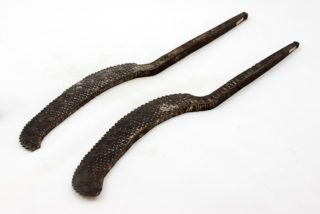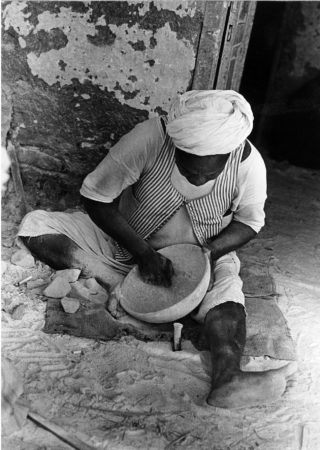Egyptian Alabaster
One of the most interesting of the ethnographic collections at the Hearst Museum was gathered in Egypt by a group of campus archaeologists. In early 1972, under the direction of Berkeley professor Robert F. Heizer, professor John A. Graham and graduate student Thomas R. Hester (PhD, 1972) collected a set of about 30 items documenting the construction of alabaster containers: a whole set of metal tools as well as unfinished and completed vessels.
Inspired by his earlier collaboration with Graham studying the transport of Olmec colossal sculpture, Heizer was then investigating how the ancient Egyptians might have moved their monumental stone sculptures. At the plain of Thebes near Luxor, in Southern (Upper) Egypt, the team came upon an alabaster workshop in the village of Sheik Abd el Gurna and decided to make a thorough investigation of their production.
The team regarded their work as an example of the then relatively new field of ethno-archaeology. Using ethnographic methods to study contemporary material culture, ethno-archaeology attempts to answer archaeological questions, largely by means of a disciplined use of analogy. In fact, Berkeley was something of a center for this kind of work, encouraged by J. Desmond Clark.

Drill bits, hand-forged iron, used for drilling centers out of alabaster vessels. Cat. No. 5-11365a,b.
Heizer, Graham, and Hester explored the quarrying of the alabaster, the complete manufacturing sequence, and the nature and organization of the workshops. They employed direct-observation, interviews, and recorded the process in hundreds of photos and 16 mm. film footage. But in attempting to make their collection, they did encounter some skepticism from the workshop leader: “The sheik thought that we were aiming to set up a rival vase-making operation. ‘Why else,’ he asked, ‘would anyone want to buy a set of tools?’ ”
Upon their return, the archaeologists examined the museum’s collection of ancient specimens, collected by George Reisner in the early 20th century. From marks on the vessels they were able to estimate how they had been made and which kinds of tools had been used. With their intimate knowledge of process, they concluded that many were poorly made, and thus were probably made as tomb offerings.

Worker using small pieces of sandstone to give a final smoothing to a vessel in 1972
The team was also able to estimate how the contemporary industry might have differed from that in ancient times. After a decline of about 2,000 years, they estimated that alabaster production had been revived relatively recently, perhaps in the early 19th century. They feared that the craft would disappear or at least be mechanized, but alabaster carving is still a thriving art in Egypt, produced mostly for the tourist trade. As the team noted, there were many such continuities in other Middle Eastern crafts. Since the 1980s, former faculty curator Carol Redmount has carried out a similar study of Egyptian pottery-production.
The alabaster workshop collection is relatively small, but it was the subject of a Hearst Museum exhibit (1974) and a relatively substantial monograph (1981). Beyond its documentation of contemporary craft traditions, the set remains as a critical source of knowledge and understanding for our world-class collection from Ancient Egypt.

